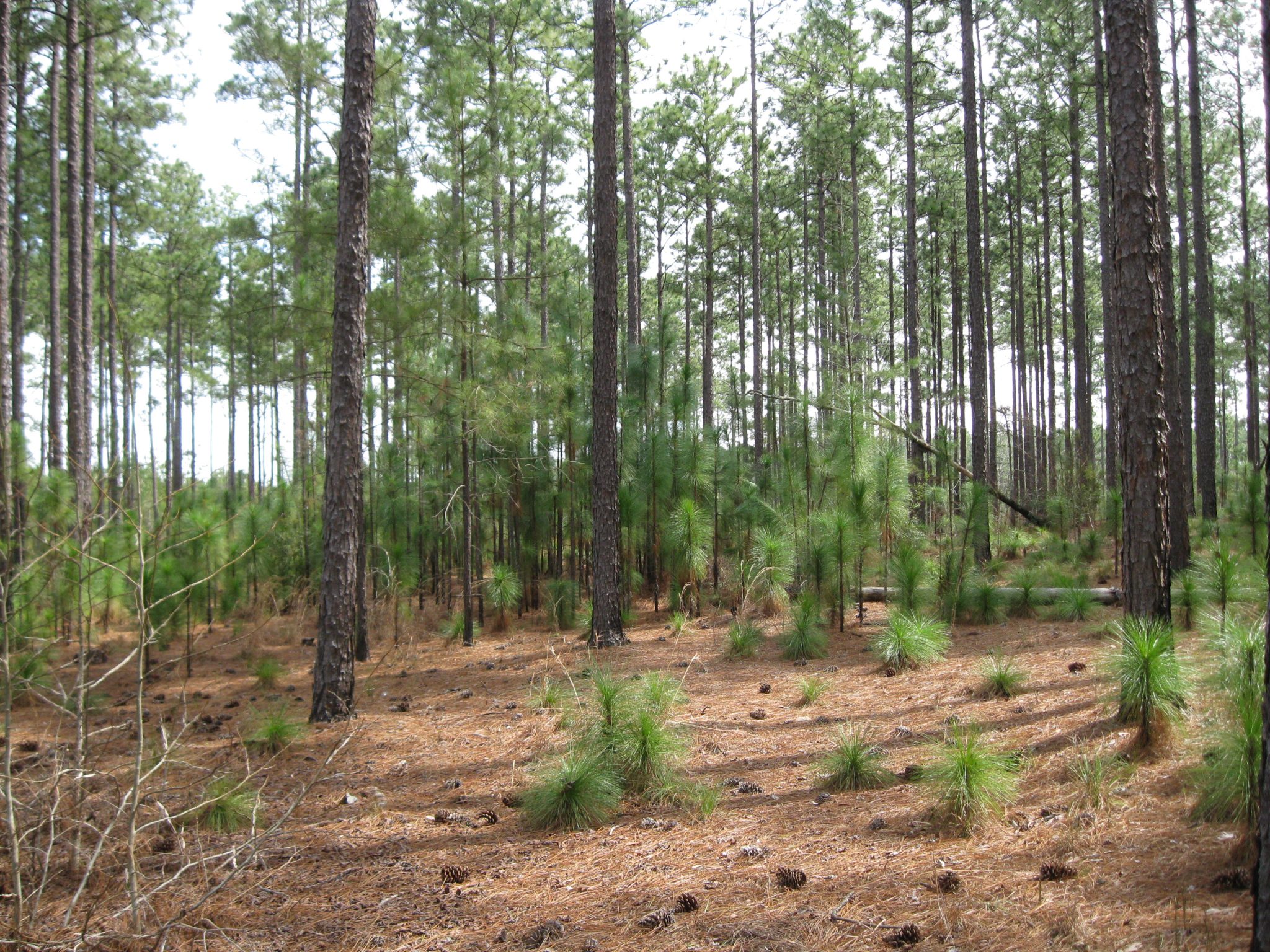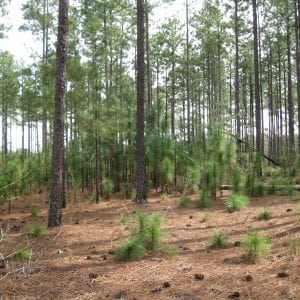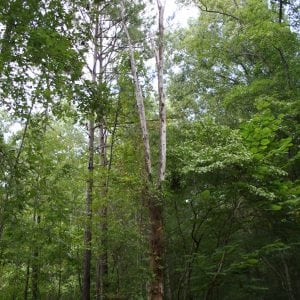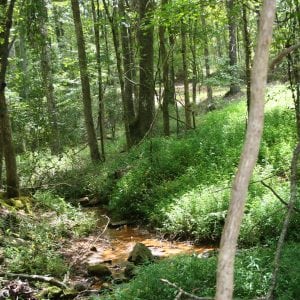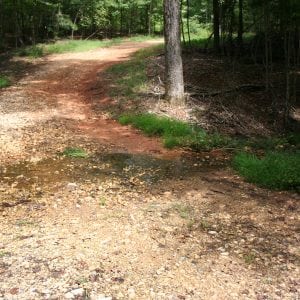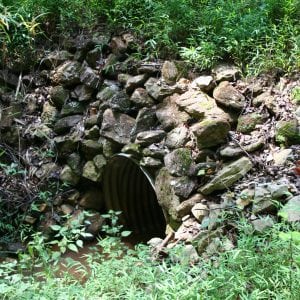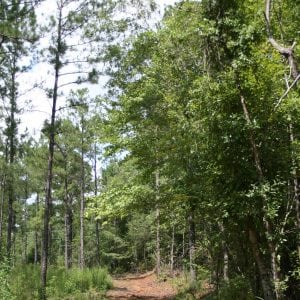Forestry

Without a basic understanding of forestry terms, it can be difficult to communicate with foresters or buyers of forestland or timber. Being well versed in forestry terminology can help landowners feel confident when making management decisions or selling their timber. This glossary is a tool for landowners seeking to define ownership objectives, develop management plans, improve their timber stands, or conduct a timber sale. Using a forestry consultant is highly recommended, and knowing these terms can help landowners better communicate with foresters and understand various forestry processes.
Forest Management
afforestation
Growing trees on land where there were none. Cost-share programs usually require that the land has not been in forest for at least several decades.
agroforestry
The practice of growing trees and agricultural or horticultural crops on the same site.
alley cropping
The practice of growing crops between rows of planted trees.
conservation buffers
The practice of growing trees in rows to alter wind flow and protect crops, reduce erosion, improve irrigation efficiency, improve water quality, and provide habitat for wildlife.
forest farming
The practice of cultivating or collecting specialty forest products in the forest environment.
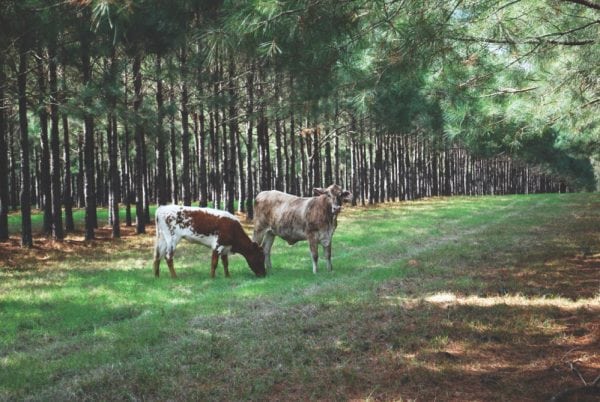
Silvopasture (photo credit: MediaAssociates)
silvopasture
The practice of grazing livestock among forest trees.
best management practices (BMPs)
Guidelines to minimize negative impacts on the environment, such as soil erosion and water pollution, before, during, and after a timber harvest or other forest management activities.
competition
The interaction between trees (of the same or different species) in which one will usually have an advantage and dominate or suppress the other.
den tree
A living or dead tree, often containing a cavity, used by animals for shelter, roosting, food supply or storage, or as a nursery.
disturbance
An event that disrupts stand structure and changes the landscape; this may be natural or human-made.
ephemeral stream
A stream that runs intermittently in response to precipitation or snowmelt. An ephemeral stream lacks a well-defined channel.
intermittent stream
A stream with a well-defined channel that has water flowing during the wet season.
mast
A food source for wildlife that is a nut, seed, or fruit produced by trees or shrubs.
nonpoint source pollution
Water pollution frequently caused by water runoff from different sources and locations. Best management practices (BMPs) can be used to help control nonpoint source pollution.
overtopping
When trees of undesirable species grow faster than those of the target species, blocking sunlight and slowing their growth.
perennial stream
A stream that has a well-defined channel and flows year-round, except during times of extreme drought.
plantation
A stand of trees planted or artificially seeded and usually grown to be uniform in structure and for a specific product class.
prescribed burning
The use of fire, under specific conditions, to achieve a variety of management objectives, including prepping a site for planting, reducing material that could fuel fires, improving wildlife habitat, and controlling vegetation competing for forest resources.
reforestation
Establishing forest cover through seeding or planting of seedlings on land where forests have been depleted through harvesting or failure to restock naturally.
slash
Branches, wood chips, foliage, and other residue on the forest floor remaining after a harvesting operation.
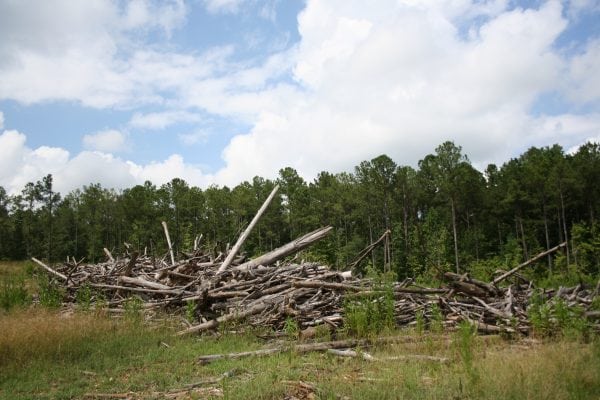
Windrow (Photo credit: Janice Dyer)
windrow
A pile or row of slash material left over after logging operations or site preparation; often later burned.
windthrow
When trees are uprooted by strong winds, often following a thinning (when trees are more exposed) or during a storm.
Forest Measurements
acre
An area of land measuring 43,560 square feet or 10 (66-foot) surveyor’s chains by 1 (66-foot) chain.
basal area
The measurement taken, usually reported in square feet per acre, of the area of the cross sections of tree trunks at 4. feet above the ground and inclusive of the bark. Basal area gives an idea of the stocking of trees in a stand.
board foot
The measurement unit for lumber equaling 1 inch thick and 12 inches square. This measurement is most often used for measuring sawtimber.
chain
The unit of length used by surveyors measuring 66 feet.
chip-n-saw
The class size for mid-sized trees (larger than pulpwood, but smaller than sawtimber) that produce both chips and dimensional lumber.
cord
The standard unit of measurement for a pile of stacked wood. A full cord stands 4 feet high by 4 feet wide and 8 feet long, a total of 128 cubic feet of space. For southern pine, there are approximately 90 cubic feet of solid wood per cord. This measurement is most often used for pulpwood.
crown
The upper part of a tree that includes branches and foliage.
crown class
A category of tree based on crown position relative to those of adjacent trees.
dominant
Trees with full crowns, receiving light from the top and sides.
codominant
Trees receiving light from the top and a little from the sides.
intermediate
Trees with crown not located in the main or upper canopy; receive some light from the top, but none from the sides.
suppressed
Trees receiving no direct sunlight from any direction; often do not make it to the upper level canopy.
dead
Trees that are no longer living but are still standing. These help to provide habitat for some wildlife species.
cubic foot
A volume of wood equivalent to a solid cube measuring 12 x 12 x 12 inches.
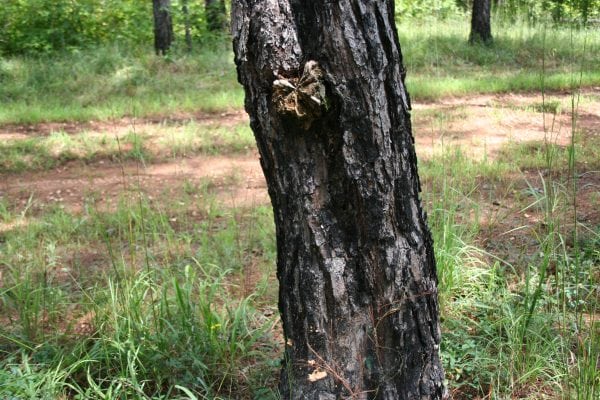
Defect (Photo credit: Janice Dyer)
cunit
A volume of wood containing 100 cubic feet; usually used to measure pulpwood.
diameter breast height (DBH)
Measurement of the diameter of a tree stem, outside the bark, taken 4 feet above the ground on the uphill side of the tree.
defect
Characteristics of a tree that may decrease its value for lumber. These can include rot, scars, or crooked stems. In forest inventories, this is often expressed as a percentage of the total volume.
dendrochronology
The history of a tree; can be determined by examining the growth rings from an extracted core, stump, or cross section of a tree.
dendrometers
Instruments used to measure height and diameter of trees.
Biltmore stick
A type of hypsometer used to measure the merchantable height of a tree and estimate the number of logs that could be harvested from the tree.
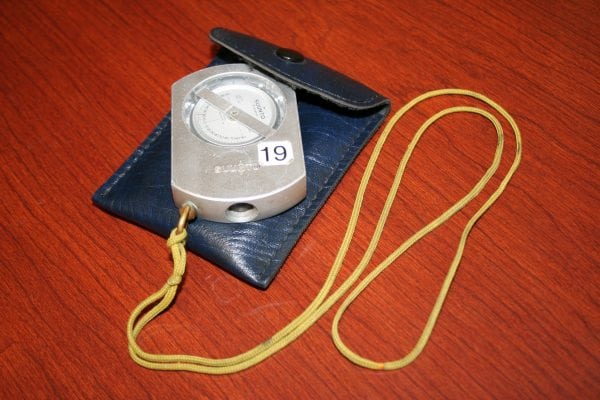
Clinometer (Photo credit: Janice Dyer)
clinometer
An instrument used to determine tree height based on slopes, elevation angles, and distance measurements.
diameter tape
Usually used at breast height, this cloth or metal tape measures diameter by wrapping the side of the tape calibrated in units of pi around the circumference of the tree.
hypsometer
An instrument (looks similar to a yardstick) used to measure the height of tall structures, such as trees and buildings. In some cases, a hypsometer is also used to determine the number of 16-foot logs in a tree.
diameter class
Classification of trees based on the diameter of the tree stem at breast height; may be used to classify into product types.
diameter outside bark (DOB)
The measurement of the diameter of a tree stem, including the bark.
face cord
Standard unit of measurement for stacked firewood standing 4 feet high and 8 feet long, with a piece length under 4 feet (usually about 16 inches).
fixed area sampling
A method of inventorying a forested area using plots of a standard size. Plots are usually square or circular and are used to assess characteristics such as species, diameter, and height of vegetation on a site.
flagging
The practice of placing flags in trees or vegetation distinguishing some kind of border (such as a property line) or identifying something in need of attention (such as a hazard).
green weight
The weight of wood immediately after it has been cut, before drying.
growing stock
The number or volume of all trees growing in a given area and meeting size and quality specifications.
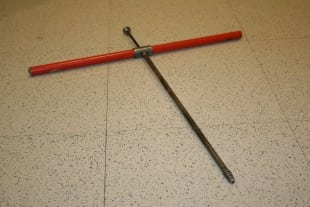
Increment borer (Photo credit: Janice Dyer)
increment borer
Used to determine the age of a tree, an increment borer includes an extractor tray within a long skinny tube. Once augured into the trunk, a sample of tree tissue is extracted and the rings are counted to determine age. For some species, additional years are added to the number of rings; for example, for loblolly pine 3 years are added, and for longleaf 7 years are added.
legal description
Information contained in documents, such as deeds and tax records, that identifies the location of land; usually uses a grid system employed by the Public Land Survey System.
metes and bounds
A system for describing property boundary lines using physical features of the land, directions, and distances; often found on tax records and deeds.
range
Designation indicating whether a parcel is located east or west of the principal meridian (an arbitrary line that runs north-south and is used for surveys in a given region).
section
An area of land measuring 1 square mile (or 640 acres); sections are broken down further into quarter sections.
township
An area of land, 6 miles square, subdivided into 36 sections and containing 23,040 acres. Township designates whether a parcel is located north or south of a baseline.
live crown ratio (LCR)
The ratio of the length of the tree’s crown (upper portion of the tree consisting of healthy, green foliage) to its total aboveground height. Often reported as percentage, LCR is an indicator of tree health.
log grade
A classification of logs based on specifications, such as length, diameter, or pith location, as well as imperfections or defects, that indicate the quality or relative value of a log.
MBF
Abbreviation indicating 1,000 board feet. This measurement unit is often used in the trade of dimensional lumber.
point sampling
A method of inventorying a forested area based on tree size to determine basal area of a stand. Samples are taken using a prism or angle gauge to determine which trees will be counted in the inventory. Point sampling does not require direct measurement of tree diameter or plot area.
poles
When referring to product classification, poles are generally trees ranging from 10 to 24 inches DBH, are at least 30 feet tall, and have a top diameter of 6 inches or greater. Additionally, they must be very straight and free of imperfections such as catfaces, forks, or fusiform rust. They generally have the highest value of any forest product and are considered a premium product.
pulpwood
A smaller class size of trees that are usually chipped and made into paper products. Larger-diameter trees of lower quality may also be purchased by mills as pulpwood.
saplings
Young trees, usually between 1 and 5 inches DBH and often have no merchantable value.
sawlog
A log (usually at least 16 feet long) from which lumber can be sawn.
sawtimber
Trees 10 inches DBH or greater and 24 feet or taller to a 6-inch top that are free of major defects such as branches, forks, or diseased stem and can yield dimensional lumber.
site
(a) The physical location of a stand of trees; or (b) the environmental conditions within which trees grow.
site class
A measure of the quality of a site and the land’s potential to produce trees.
site index
A measure of the quality of a site and its productivity based on the average heights of the tallest (dominant and co-dominant) trees in a stand at a given base age (usually 25 or 50 years). Site index is specific to particular species, climates, and regions, and is used to prescribe silvicultural practices and project future tree growth.
site quality
A measurement, based on standard indicators, of the land’s potential to grow trees. Usually refers to the productive potential of a particular species at a given time and location.
stand density
A direct measure of crowding of trees in a stand; can be measured in terms of trees per acre, basal area, or volume per acre. Measurements of stand density are used to determine silvicultural prescriptions.
stand growth
A change in the volume and productivity of trees.
stand improvement
Forest management practices, usually involving the removal of undesirable trees, that allow the best trees to develop more quickly and improve overall growth, composition, structure, and health.
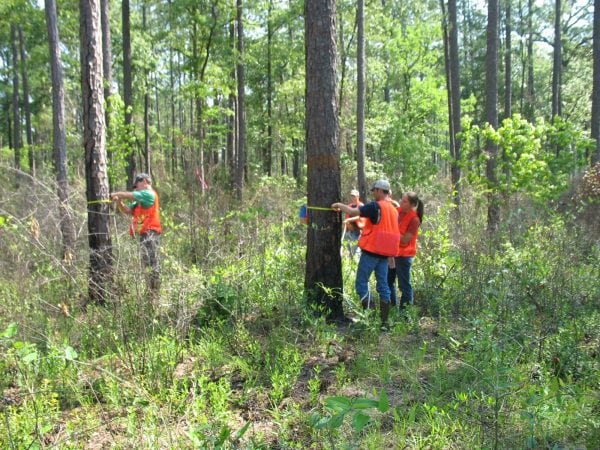
Timber cruising (Photo credit: Becky Barlow)
stocking
A relative measure of stand density compared to a “normal” or desired stocking level; can vary based on management objective.
structure
How trees are spatially distributed across a site (either vertically or spatially in groups or clusters).
timber cruise
A statistical sample of a forest area to determine the location, volume, and other characteristics of timber, usually in preparation for a harvest or to guide management decisions.
ton
A measurement of gross weight, usually given for green (not yet dried) material. This measurement is often used to determine the amount of wood delivered to the mill.
yield
The volume of standing trees on a site.
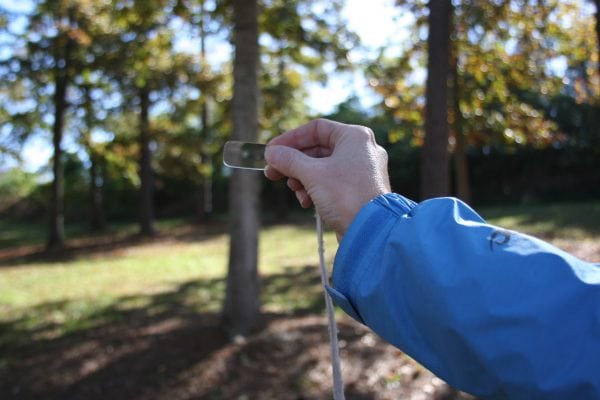
Using a wedge prism for a forest inventory (Photo credit: Becky Barlow)
wedge prism
A small, slightly angular piece of glass used when sampling variable radius points to determine whether a tree is to be included in an inventory.
Silviculture
bedding
A mechanical method used to prepare a site for planting seedlings, bedding involves plowing the ground to form cultivated ridges. This technique is often done in conjunction with subsoiling.
coppicing
A management method, usually used to regenerate hardwoods, in which tree stems are cut near the ground and shoots emerge from the stump.
disking
Preparing a site for reseeding or planting by plowing the ground with disks to mix organic material into the soil. This method may also be used to encourage regrowth of native understory plants.
drum chopping
A mechanical site preparation technique used to break up slash material and other vegetation above the soil surface.
even-aged management
A method of maintaining a stand of same-age trees.
clear cut
Harvesting all commercially valuable trees in a forest stand during a single operation.
seed tree method
An even-age reproduction practice in which only a few widely spaced seed-bearing trees are left standing in each acre as a seed source for regeneration.
shelterwood method
An even-age reproduction practice in which multiple successive cuttings remove the majority of trees, but some of the older trees are left standing to be a seed source and provide protection for regeneration.
rake and pile
A mechanical site preparation technique in which material is raked, pulling up roots, and piled into windrows; usually not appropriate for highly erodible soils.
scalping
A practice used when preparing a site for planting or seeding; the top layer of vegetation is cut with a mechanical plow, and then pulled up, exposing the soil. Scalping generally occurs on old pastures, heavy in grasses, being converted to forest.
scarification
A technique in which the soil surface layer is broken up in preparation for planting or regeneration.
seedbed
An area of soil prepared (naturally or artificially) to encourage the germination of seeds and growth of seedlings.
seedlings
Young trees; size varies by species and can range from only a few inches in height to taller, but usually less than breast height (4½ feet).
shearing
A mechanical site preparation technique used to remove standing, nonmerchantable material, often following a clearcut.
silvics
Biological characteristics of individual trees that determine how they will grow and reproduce.
silviculture
The manipulation of a forest stand to achieve desired production outcomes.
- Longleaf pine seedlings (Photo credit: Becky Barlow)
- Snag (Photo credit: Janice Dyer)
- Streamside management zone (SMZ) (Photo credit: Janice Dyer)
snags
Standing trees that are dead or dying. Snags provide habitat for various plant and animal species.
stagnation
Occurs when growing space between trees is limited, increasing competition for resources. The result is a forest stand with slow growth that makes trees susceptible to disease and insects.
stand
A group of trees or vegetation with the same structure and similar growing conditions. Other criteria include tree age and species composition (e.g., longleaf pine or a pine-hardwood mix).
streamside management zone (SMZ)
Strip of forested land alongside a stream that is maintained to protect water quality.
subsoiling
A practice used in site preparation that involves breaking up deep, dense soil layers, and alleviating effects of compaction. Subsoiling is often conducted following scalping or a controlled burn.
thinning
A management practice of removing selected trees to encourage the growth and health of remaining trees. This practice should occur before a stand stagnates and becomes susceptible to pests and disease.
uneven-aged management
A method of maintaining a stand of different tree ages through periodic thinning. Stands under this management technique have no beginning or end and attempt to mimic a more natural system.
single-tree selection method
A uneven-aged reproduction practice in which individual trees of the oldest-age class are removed to create openings in the stand and to allow regeneration to occur naturally.
watershed
An area of land where water from rain or melting snow drains through a system of streams into a body of water, such as a river or lake. The boundaries of a watershed are defined by topographical features, such as hills or ridges.
Timber Harvesting and Road Construction
broad base dip
An erosion control practice for roads; a shallow depression constructed diagonally across a woods road to drain water off the road.
buffer strip
An area of land in vegetation that is (a) located downslope from forest activities that protects from sediment runoff, especially along vulnerable water sources; or (b) used in forest aesthetics to improve the visual quality of forestry practices, such as clearcutting.
constructed ford
A stream crossing—usually made of rocks placed across a forest road—that can be driven across when the water level is low.
culvert
A pipe usually made of metal, PVC, or concrete that allows surface water to flow beneath roads.
easement
A right to the use of property by another party.
firebreak
A gap in vegetation, either natural or human-made, that may help to prevent ground fires from advancing.
- Constructed ford (Photo credit: Janice Dyer)
- Culvert (Photo credit: Janice Dyer)
- Firebreak (Photo credit: Janice Dyer)
logging deck
A centralized location where harvested trees are collected, delimbed and loaded onto trucks. Logging decks need to be carefully maintained to control runoff and erosion.
rip-rap
Rock or other large material used to protect against runoff and for erosion control.
skid trail
A temporary, unsurfaced path used by loggers to drag cut trees from the stump to the logging deck. Skid trails need to be carefully maintained to control runoff and erosion.
skidder
A specialty tractor that is used to haul logs out of a forest once they are cut. This tractor consists of a large grapple arm in the rear, used to bunch and drag whole trees from the woods, and pivots at its center, used to accommodate tight-turning radiuses in the forest settings.
skidding
Dragging fallen trees along the forest floor; during harvest, trees are skidded to the logging deck, where they are loaded on trucks for transport.
stumpage
The value of standing timber in a woodlot, determined by a number of factors, including species, size and quality of trees, and market conditions.
water bar
A road feature consisting of a shallow channel or hump running diagonally across the road surface to divert water and prevent erosion. Water bars are often a more rudimentary method for diverting surface water, while broad base dips allow for easier crossing of vehicular traffic.
For more information on words defined in this publication, as well as other forestry terms, visit the online Dictionary of Forestry provided by the Society of
American Foresters, or consult the Alabama Forestry Commission’s Best Management Practices manual.
Janice Dyer, Research Associate, Agricultural Economics and Rural Sociology and School of Forestry and Wildlife Sciences, Auburn University, Becky Barlow, Extension Specialist and Assistant Professor, School of Forestry and Wildlife Sciences, Auburn University, and Beau Broadbeck, Regional Extension Agent
Reviewed October 2022, Common Forestry Terms for the Forest Landowner, ANR-1373

